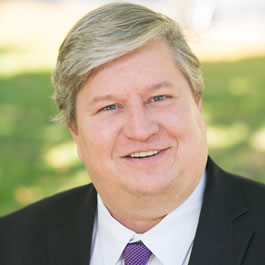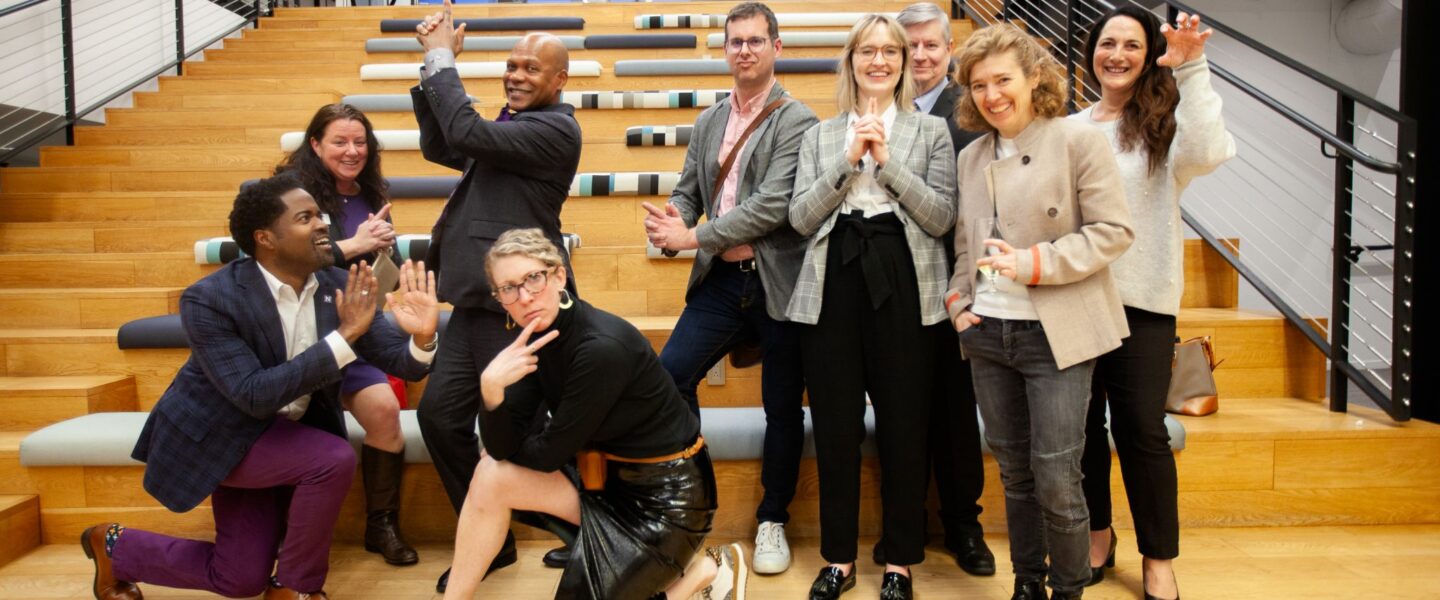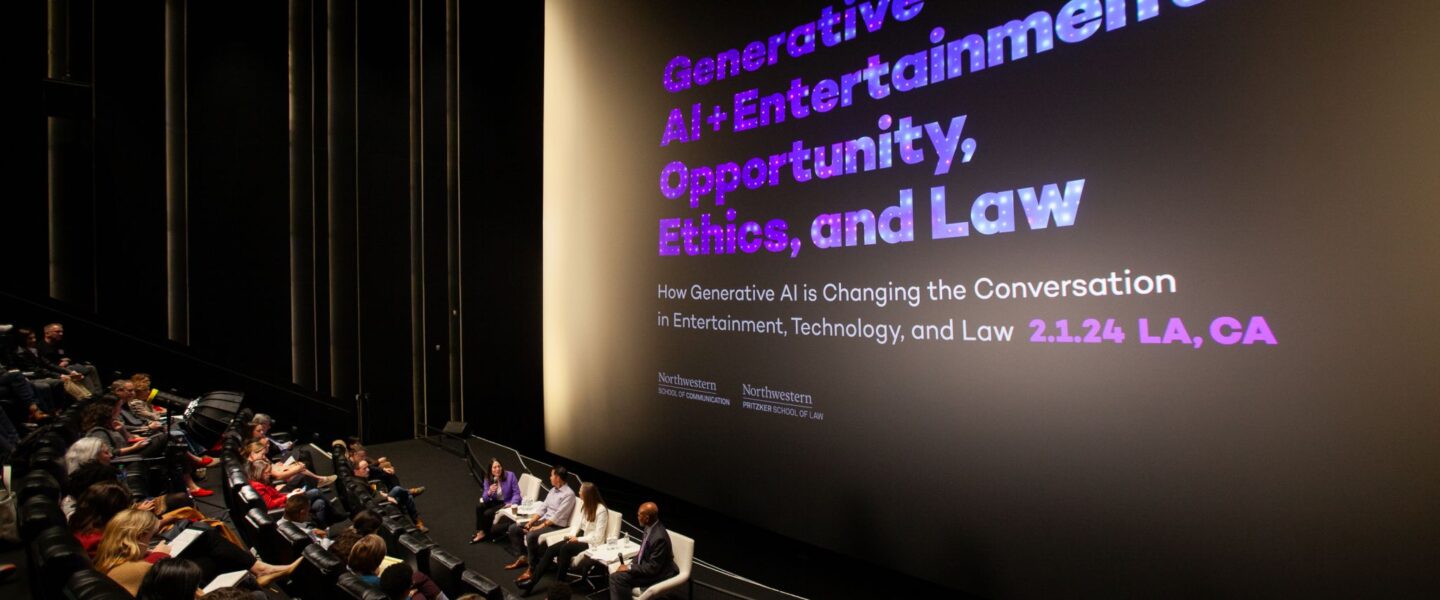 Professor of Instruction Rick Morris remembers the rise of cable television, the transition from analog to digital signals, and the first high-definition (HD) TVs, which sold for thousands of dollars.
Professor of Instruction Rick Morris remembers the rise of cable television, the transition from analog to digital signals, and the first high-definition (HD) TVs, which sold for thousands of dollars.
Working for brands like NBC, Telemundo Chicago, and Disney ABC, he helped automate media plants, supervise productions, manage millions of dollars in technology development, and lead digital station conversions to HDTV. And he did it all through a legal lens with two law degrees: a J.D. and LL.M.
“Technology transition is central to what I’m about, what I do, what I study, and what I teach,” he says. That’s why an encounter a few years ago with a deepfake—a digitally altered image generated through artificial intelligence (AI) and machine learning—caught his attention. While deepfakes closely align with image-manipulation technology used to create wonderful experiences in movies, their movement from the margins spurred more questions than answers for Morris.
He knew AI was a development worth watching—and watch he did. A few years later, when he saw AI’s potential impact on the entertainment industry grow, he started to pay even closer attention. It wasn’t long before writers and artists became concerned about AI not only using their material but also supplanting their careers. “Then, in the past year, we saw image manipulation move more into the mainstream,” he describes. “After that, we saw AI create entire visual stories.”
Now, he says, creative artists are beginning to suss out the differences between using AI as part of their creative process and AI becoming a substitute for their work. For example, could artists producing photorealistic images be more creative if they integrated AI into the process? “It’s complicated and takes a big, long prompt that must be refined—is that still art?” asks Morris. “It’s art in the same way CGI was art when it first became part of the post-production or production process. Those are the kinds of questions we’re wrestling with: tension vs. point of advancement.”
Using Real Examples to Make Entertainment Law Relatable
In his course, Arts and Entertainment Law and Ethics, Morris aims to make the law of entertainment understandable to those who aspire to work in the industry. To cover all aspects of the topic in 10 weeks, he begins with discussions about intellectual property before moving on to conversations about contracts—and then combines the two.
Students also learn what steps to take to protect creative work and complete a mock filing of a copyright registration. Once the course is over, they have practical experiences and a library of materials to take with them.
Weaving in real examples is key to how he teaches. “This way, students experience a quick theory-reward ratio,” he says. “They see the theory of the law one week and watch it applied the next week. We look at real controversies. They are responsible for analyzing the facts and the law and applying them as they would in law school. They have to think about who they need permission from, whether they can make any money off a project, or whether the work can be sold—all real considerations.”
Two Exercises to Explore the Duality of AI
Last fall, to help students understand the duality of AI, he incorporated two exercises into his teaching.
1. Write a contract using AI
The experiences were inspired by real situations where lawyers used AI to generate contracts—but the technology was inaccurate. “Is it permissible to use AI to write a contract? Yes,” says Morris. “But the lawyer is still responsible for the result. There have been several cases where lawyers were cited by judges for attempting to use AI without proper filtering or correction. When you’re dealing with cases where someone’s set to lose a lot of money, incorrect content becomes a big problem.”
He kicked off the first hands-on project by giving a prompt to a free AI tool: create a contract to acquire a piece of intellectual property. The result? The tool wrote a contract, but it wasn’t a good contract, he says. While it included basic clauses, it wasn’t comprehensive.
After they had a chance to review what AI generated, students were asked to comment on and criticize the contract. Then they worked together to create a better, more detailed prompt to see how the results might change. The AI tool delivered a better contract, but it still wasn’t a document that could be used in the real world.
“We got to see the advantages and the drawbacks of using AI firsthand,” says Morris. “The tool created a contract in under a minute, which was wonderful. If you need to do something very basic, this might work as a starting point. From that perspective, AI could help advance the arts and sciences by getting rid of the busywork we do in order to get ready for our creative work.”
2. Write a song using AI
The contract exercise covered the business side of the industry, but Morris also wanted students to see AI at work on the creative side.
“We asked the tool to write a song about being happy to finish an MSLCE course,” says Morris. “What it gets right and wrong is equally fascinating. It did write a song, and it figured out that M-S-L-C-E was our acronym and was focused on entertainment.”
The class then explored the technology’s songwriting capabilities when it came to creating art in different styles: Taylor Swift, Doja Cat, Olivia Rodrigo, and Elvis Presley, for example.
“We got to see in real-time the dichotomy of what it’s capable of doing and where it begins to falter,” he explains. “The work it scraped and created a derivative of may involve plagiarism or lack of permission, which is another conversation—but it was inspired,” he explains.
Taking AI Outside the Classroom
Morris takes every opportunity he can to talk about technology transition—not only inside the classroom, but outside as well.
In February, he was the co-convenor of a one-day collaborative conference called Generative AI + Entertainment: Opportunity, Ethics, and Law. Held in Los Angeles, it was a chance for faculty from two Northwestern schools—the School of Communication and the Pritzker School of Law—as well as leading alumni in the entertainment field, to gather and discuss AI’s place, potential, and limitations in the creative industries.
“There were thoughtful conversations about artificial intelligence from a legal perspective, user perspective, creative perspective, and theoretical perspective,” says Morris. “It was a great sharing experience across multiple dimensions that I can use to help prepare students for what’s to come.”
Read more on our blog and follow Northwestern’s MS in Leadership for Creative Enterprises program on Facebook, Instagram and Linkedin.


